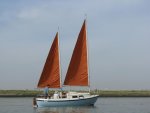NickRobinson
Well-known member
Any link/wisdom as to why junk masts don't seem to need stays? The w/sites just praise or diss them in general terms.
I note that they are keel stepped so have support from the cabin top, even so, I can't get my head round this, surely if a sail is driving a hull at x knots there are forces to counter whatever the sail plan.
Ditto under bare sticks bashing about in a seaway.
I note that they are keel stepped so have support from the cabin top, even so, I can't get my head round this, surely if a sail is driving a hull at x knots there are forces to counter whatever the sail plan.
Ditto under bare sticks bashing about in a seaway.


